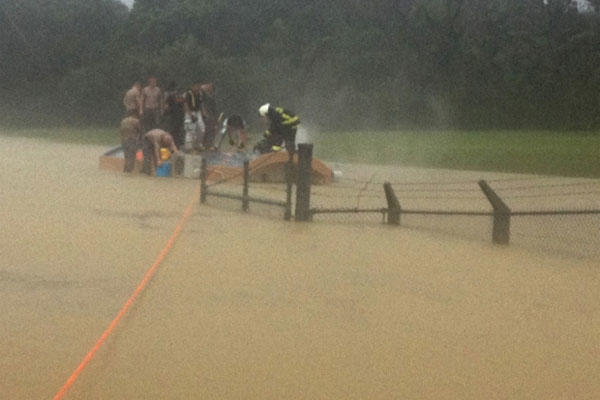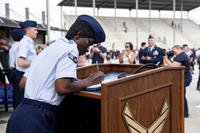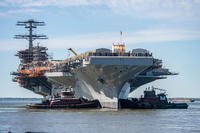KADENA AIR BASE, Japan -- "Bro, I can't believe we got out," said Airman 1st Class Brandon Miles to Airman 1st Class Roderick Jones when thinking back on the events of that early morning July 9, 2014.
The two 18th Security Forces Squadron response force members had been rescued by a team of first responders while on duty here during Super Typhoon Neoguri, which struck the western coast of Okinawa, Japan, July 7-9th.
Raging its way through Okinawa, pounding the island with wind gusts up to 100 mph and heavy rain fall, Neoguri, the Category 4 typhoon, made its presence known. After two days, Kadena held up to the blunt force of the super typhoon and the island was placed in Typhoon Cyclone Condition of Readiness 1-Recovery. TCCOR-1R allowed for emergency essential personnel, such as the civil engineers, medics, firefighters and security forces, assigned to Kadena to begin assessing and reporting damage done to the base.
It was just a another shift for 18th Security Forces members Miles and Jones, defenders who were assigned to the Munitions Storage Area guard shack, line gate 19.
The two members, good friends, guarded the gate in the confines of the guard shack, checking the scarce vehicles that did come, passing the time with friendly conversation and working on career development courses.
"Most of night was spent talking and doing CDCs," Miles said. "We were sitting in there minding our own business."
Around 6 a.m., the defenders noticed water slowly rising under the underpass of the munitions gate and notified the Base Defense Operation Center of the current situation by way of radio. Shortly after, water began to seep in from under the door of the guard shack due to a rapidly forming river located on the back side of the building.
"We slowly began to notice flooding moving up toward the gate, and after a while we heard gushing water coming from behind us." Miles said.
Jones responded by alerting BDOC of the situation over the radio, stating the water was rising and he and Miles were unable to get the shack door open.
BDOC quickly dispatched Master Sgt. Brad Reeves, 18th SFS flight chief, and eight other defenders to head out to the scene and evacuate the trapped defenders in the guard shack. They also contacted Kadena Fire Emergency Services who sent two fire engines out to the scene.
The responders found the area was flooded and impassable due to the heavy rain from the super typhoon and determined the only way to get to the site was to go off road or by foot.
"We attempted to take Perimeter Road, and later Highway 74, and found both had been flooded and impassable," Reeves said. "So I decided to go back to Perimeter Road and reach them by foot."
Back at the guard shack, with continued communication with BDOC and Reeves, Jones requested permission to shoot out a window using his assigned 9MM weapon. Reeves immediately denied the request, due to the windows in the shack being bullet proof and fear of the bullets ricocheting in the confined space.
All patrols arrived on scene at 7 a.m. Assessing what lay ahead, the responders noticed the water was now almost to the roof the guard shack, leaving the Airmen trapped inside with zero visibility and heavy rain showing no signs of stopping. Reeves and another 18th SFS member hopped in the water, ensured the water current was passable and proceeded to cut the locks on the gate. They were followed by the team of cops and firefighters who swam to the guard shack and secured a safety line to the shack.
"The gate shack was under at least 10 feet of water now," Reeves said. "We began swimming toward the guard shack immediately after getting past the gate. Some of the Airman began trying to open the door and break windows."
Unable to get to the door and out of any other options, the responders decided to get inside of the shack by creating a hole in the roof.
The responders grabbed tools such as axes, sledge hammers, k-12 saws, multi-tools, chisels and pry bars, and swam through the flood water using the safety line to get to and from the guard shack. After climbing onto the roof, they tried cutting a hole using a k-12 saw until it malfunctioned. With the k-12 out of commission, responders took turns hacking away at the 8-12 inches of reinforced concrete that stood between them and the trapped Airmen.
"We just grabbed what we could," Reeves said. "We kept switching in and out, taking turns striking the roof to break a hole through to get them out."
Trying to stay calm but desperate for air, the two trapped defenders ran out of ideas. Panicking, Jones banged his head on the ceiling and damaged the tile.
Realizing the ceiling could be broken through, the defenders clawed the ceiling with their hands until they reached metal railings. Breaking the railing and un-doing the latches revealed more room and breathable space but a concrete layer that just couldn't be broken through by bare hands.
"After we got past the roof and unlatched the railing, I could hear the responders on top of the guard shack and began to communicate with them, "Jones said.
When a corner of the shack began to crumble and with debris falling, Miles swam over and alerted the responders that he and Jones were still alive. They began motivating and encouraging the responders to keep going and received encouragement back. The hole grew larger and the trapped defenders grew more confident they were going to make it out, even with the water now inches from the ceiling.
"We saw light, it was coming through," said Jones.
Master Sgt. Duggins, 18th Civil Engineer Squadron assistant chief of operations, and another firefighter grabbed replacement k-12 saws and blades and other tools and transferred the equipment across the water using the safety line. With the equipment, the team was able to cut a hole approximately 12 x 18 inches through the roof and reach the trapped Airmen.
"I looked into the hole and saw no more than 6 to 8 inches of breathing space left," said Duggins.
The responders pulled Miles out of the flooded shack first. Duggins assisted Miles across the water and got the cold and shaking Airman to the on-scene medical ambulance for assessment.
Next was Jones, but he was unable to fit through the hole in the roof. The teams of first responders chiseled away at the opening, and after a few minutes were able to make a larger hole for Jones, and pulled him from the shack.
"We weren't sure we were going to get out, and when we did it felt amazing," said Jones. "I was freezing, but it was amazing."
After rescuing the Airmen, Reeves and Duggins checked to see how much breathable space was left in the shack, revealing within only a few moments anyone still trapped inside would have drowned. Jones and Miles were transported to Fire Station 1 where medical personnel further examined them.
"The lives of these two Airmen were in our hands," Duggins said. "It's only that we had faith in each other and confidence in one another that this rescue operation was a success."
Back at the scene, after taking accountability for all personnel and equipment, the team of first responders departed back to their respective squadrons for debrief.
The team of cops and firefighters who responded to the scene, worked together to save the lives of their wingmen. Understanding the concept of having a wingman, and helping each other through critical situations by staying motived and calm, proved vital for Jones and Miles.
"They were there for us the whole time," said Miles. "They did not leave their wingmen behind."



























